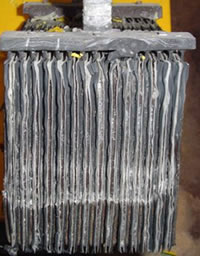Technical info - Sulfation
Sulfation
When a battery discharges, lead and lead dioxide, which are the active materials on a battery’s plates, react with the sulfuric acid in the electrolyte to generate electrical current. A finely divided, amorphous form of lead sulphate is produced. During charging, the amorphous lead sulphate is easily converted back to lead, lead dioxide, and sulfuric acid, in essence returning the battery to its former state.
If a battery is not fully recharged soon after a deep discharge, the lead sulphate will crystallize. These large crystals clog the pores of the active mass and cover the plate surface so that charging becomes impossible. The result of sulfation is permanent loss of capacity. The sulfated active material of the positive plate is often light-coloured. A typical characteristic is the sulphate stripe at one-third of the height of the plates (see photo).
As the sulfation goes on, the active mass may be pressed out of the grid so forcefully, that the grids will bend! Charging a sulfated battery may cause dendrites to form at the negative plate. These sharp, needle shaped crystals can short circuit the positive and the negative plates.

